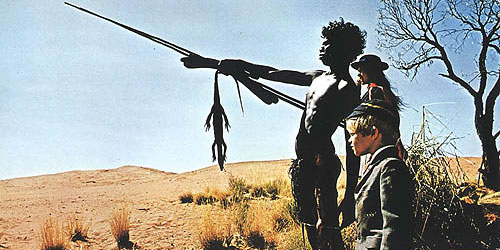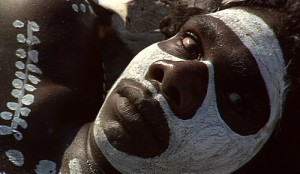There are those special movies that change your life after you’ve seen them. Then there are the almost miraculous movies that stay inside you and then change your life again every time you return to them. Critically acclaimed upon its initial release in 1971, but long considered the ultimate cult classic, Nicolas Roeg’s Walkabout is receiving the well-warranted Criterion Collection treatment.
That it comes unreservedly recommended is certain; the new special edition DVD obliges the inevitable question: what makes this one of the landmark films of the last half-century? Answer: as a near perfect amalgamation of image, story and sound, Walkabout remains vital — and provocative — for its ability to present complicated questions that cannot (and need not) readily be answered. Like any memorable work of art, this movie manages to convey certain elusive insights that, upon reflection, are so obvious they seem revelatory.
Considered on its most basic terms as a deeply moving and occasionally disturbing drama that features consistently astonishing cinematography, Walkabout is entirely successful. As a subtly, almost casually polemic work, it is certain to compel just about any viewer to consider the world, and their preconceptions, in a slightly (or radically) different way. On deeper levels, the film’s refreshing lack of calculated profundity allows the arresting vistas of the Australian Outback — at once gorgeous and grim — to serve as both setting and a wordless commentary that speaks volumes.
Roeg, in his directorial debut, was the ideal champion for this material, taken from a novel by James Vance Marshall. Already an accomplished cinematographer, Roeg creates a continuous loop of scenes that pulsates with uncontrived symbolism, capturing some of the most audacious images ever to appear in a motion picture. Roeg, by trusting his eye and his environment, captures what Werner Herzog has described based on his experiences filming in the jungle: the so-called natural world is teeming with colors and humming with life, but the closer you look the more dangerous it appears.
Where Herzog uses long tracking shots (particularly the famous opening scene of Aguirre: The Wrath of God or multiple sequences in Fitzcarraldo) as an almost disarming strategy to illustrate the grandeur, Roeg pans in on the battles being waged in the wide open spaces of the desert. In either case, one quickly understands that the resplendent birds are actually shrieking in warning, not song, and that those colorful lizards are running toward prey or away from a predator. Despite our tendency to romanticize (or our historical obsession to tame) the wilderness, an unblinking assessment reveals an arena where every inch of space is occupied by an unending struggle for the inhabitants — no matter how large or small — to stay alive.
The plot of Walkabout, allegedly requiring the most succinct of screenplays (by British playwright Edward Bond, who provided what Roeg described as “a fourteen-page prose poem”), is more or less a variation on the classic coming of age parable. The action — and conflict — gets underway quickly when a teenager and her younger brother are stranded in the desert after their father abandons them in a most unsettling fashion. This scene is as surprising as it is appalling, but Roeg deftly orchestrates the turn of events so that they occur almost matter-of-factly. This would be impossible if not for the capable and perfectly cast actors, as well as an obvious comfort with and confidence in the material.
Standing in the overwhelming nowhere of the Australian Outback, the sister (Jenny Agutter) quickly comprehends that she somehow must protect her little brother (Roeg’s son Luc, credited as Lucien John) and find a way back to civilization. The camera languidly tracks their uncertain march, with scorching brightness succumbing to the moonlit chill of night. The slow panning shots of the endless landscape emphasize how helpless these children are, with neither dialogue nor sentiment. The sister encourages and cajoles her brother, careful not to acknowledge their lack of food and whether they are moving closer to safety or further into the desert.

An unexpected salvation arrives when the children encounter a native (David Gulpilil) who is undertaking his walkabout, a solitary excursion Aborigine males embark upon as the symbolic entrance into adulthood. The young man, roughly the same age as the sister, is unable to speak their language but eventually comprehends their distress. In a matter of moments we see him find water and hunt his food, an almost offhand commentary on the way he thrives in an environment that would have killed the children.
In the days that follow the children are taught — and begin imitating — techniques for survival, and a gentle, mutual bond is established. Stripped of her cultural ascendancy, the girl is at once grateful for and humbled by the Aborigine’s presence. The younger brother, less guarded and more innocent, is able to communicate without speaking, using gestures and sounds. The sister becomes increasingly cognizant of her surroundings, and a connection to the land that is much less tenuous than she could ever have imagined while ensconced in the secure routine of an urban existence.
During the course of what is presented as a typical day we see kangaroo skulls bashed in, large lizards impaled with sticks, sun-blistered skin, and amphibians devouring each other. Yet, the most disturbing sight by far — not surprisingly — is the short, sickening scene of a white man exploiting cheap labor from some natives. This ostensibly unconnected fragment functions like several similar moments where Roeg crosscuts images and action. In another, the Aborigine prepares his kill before a fire while (simultaneously) the scene is cut with a white-aproned butcher cleaving meat in a kitchen. These skillfully presented touches convey all that needs to be said without pretense or bathos.
Eventually the group finds an abandoned farmhouse, positive indication that they are in proximity to civilization. The tables subtly shift and now it is the Aborigine who seems slightly confused and out of place. In a poignant, quietly devastating scene, he observes a couple of hunters casually tracking their quarry from the safe distance of an off-road vehicle, then pumping it full of shotgun shells. The absurd juxtaposition of these camouflage-clad sportsmen and the almost-naked native is an entire commentary delivered in a sequence that lasts seconds. The lack of comprehension and the look of disenchantment etched on his face as the men drive off is an image that will stay with the viewer for a very long time.
The film’s most surreal, and strangely wonderful sequence occurs when the Aborigine, misconstruing the girl’s gratitude for love, performs a ritualistic courting dance for her. It is a scene that ends almost as quickly — and silently — as it begins, but the subsequent events will forever change both people’s lives. As the film concludes, everything is brought full circle, with a twist.
Years later, reintegrated into the city routine, the girl’s husband, back from another day at the corporate grind, enters their apartment. As he relays the office politics du jour, she is distracted by what appears to be a recurring daydream. In an alternate vision of how her life may have played out, she recalls the Aborigine who saved her life and offered his love, and envisions herself back in that world — a world that suddenly seems tranquil and inviting. It is a vision signifying the serenity — and soul — that her high-rise ocean view, and the life her choices have brought her is very obviously bereft of.
Walkabout, then, is sufficiently convincing, and satisfying, the first time one sees it, but it demands repeated viewings. The first experience offers enough twists to rivet and disorient; subsequent screenings will enable greater scrutiny (and appreciation) of the visuals, the colors and the sublime soundtrack. It requires more than one viewing to process — and register — the innumerable moments that illuminate Roeg’s genius for detail, whether it’s that awkward look the father and daughter exchange in their car, or the brother licking salt out of his sister’s hand, or a lizard scurrying out of a soda can. These moments add up to an experience that only accrues significance and resonance the more one engages with the world. Mostly, it remains an enriching example of the opportunities great art affords us in our collective quest to understand who we are and why we’re here.
As you should expect from a Criterion reissue, this latest incarnation looks and sounds spectacular: if you have never owned Walkabout on DVD, this is the type of film that justifies the expense and epitomizes the positive aspects of newer and better technology. To be certain, one does not need a big flat panel with surround-sound to fully enjoy the many charms of this particular film, but let’s face it, it’s the next best thing to seeing it in a theater.
The bonus disc contains brief and fascinating interviews with two of the stars. Agutter reminisces about her experience on the set and has nothing but positive things to say about the cast and crew. The other interview, with Luc Roeg — an industry veteran who produces films — is equally worthwhile. He discusses the unique opportunity of working with his father, and how his role was presented as an adventure in order to acquaint him with the process of acting (particularly for such a challenging on-location set).

Finally, and most intriguing, is the hour-long feature on David Gulpilil, who has enjoyed a long acting career while (literally) remaining true to his roots, balancing a life between movie sets and his family home in the bush. This documentary could easily be sold and marketed as an immensely worthwhile addition to any movie fan’s collection; that it comes packaged with the movie that introduced him to the world should elevate this edition of Walkabout to the top of your must-have list for 2010.


